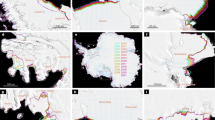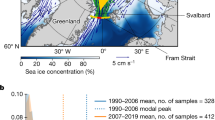Abstract
Floating ice shelves, which fringe most of Antarctica’s coastline, regulate ice flow into the Southern Ocean1,2,3. Their thinning4,5,6,7 or disintegration8,9 can cause upstream acceleration of grounded ice and raise global sea levels. So far the effect has not been quantified in a comprehensive and spatially explicit manner. Here, using a finite-element model, we diagnose the immediate, continent-wide flux response to different spatial patterns of ice-shelf mass loss. We show that highly localized ice-shelf thinning can reach across the entire shelf and accelerate ice flow in regions far from the initial perturbation. As an example, this ‘tele-buttressing’ enhances outflow from Bindschadler Ice Stream in response to thinning near Ross Island more than 900 km away. We further find that the integrated flux response across all grounding lines is highly dependent on the location of imposed changes: the strongest response is caused not only near ice streams and ice rises, but also by thinning, for instance, well-within the Filchner–Ronne and Ross Ice Shelves. The most critical regions in all major ice shelves are often located in regions easily accessible to the intrusion of warm ocean waters10,11,12, stressing Antarctica’s vulnerability to changes in its surrounding ocean.
This is a preview of subscription content, access via your institution
Access options
Access Nature and 54 other Nature Portfolio journals
Get Nature+, our best-value online-access subscription
$29.99 / 30 days
cancel any time
Subscribe to this journal
Receive 12 print issues and online access
$209.00 per year
only $17.42 per issue
Buy this article
- Purchase on Springer Link
- Instant access to full article PDF
Prices may be subject to local taxes which are calculated during checkout



Similar content being viewed by others
References
Thomas, R. H. The creep of ice shelves: interpretation of observed behaviour. J. Glaciol. 12, 55–70 (1973).
Hughes, T. Is the west Antarctic Ice Sheet disintegrating? J. Geophys. Res. 78, 7884–7910 (1973).
Dupont, T. K. & Alley, R. B. Assessment of the importance of ice-shelf buttressing to ice-sheet flow. Geophys. Res. Lett. 32, L04503 (2005).
Paolo, F. S., Fricker, H. A. & Padman, L. Volume loss from Antarctic ice shelves is accelerating. Science 348, 327–331 (2015).
Bindschadler, R. A. Hitting the ice sheets where it hurts. Science 311, 1720–1721 (2006).
Pritchard, H. D. et al. Antarctic ice-sheet loss driven by basal melting of ice shelves. Nature 484, 502–505 (2012).
Wouters, B. et al. Dynamic thinning of glaciers on the Southern Antarctic Peninsula. Science 348, 899–903 (2015).
Rott, H., Rack, W., Skvarca, P. & De Angelis, H. Northern Larsen Ice Shelf, Antarctica: further retreat after collapse. Ann. Glaciol. 34, 277–282 (2002).
De Angelis, H. & Skvarca, P. Glacier surge after ice shelf collapse. Science 299, 1560–1562 (2003).
Hellmer, H. H., Kauker, F., Timmermann, R., Determann, J. & Rae, J. Twenty-first-century warming of a large Antarctic ice-shelf cavity by a redirected coastal current. Nature 485, 225–228 (2012).
Rignot, E., Jacobs, S., Mouginot, J. & Scheuchl, B. Ice-shelf melting around Antarctica. Science 341, 266–270 (2013).
Dutrieux, P. et al. Strong sensitivity of Pine Island ice-shelf melting to climatic variability. Science 343, 174–178 (2014).
Church, J. A. et al. in Climate Change 2013: The Physical Science Basis. Ch. 13 (eds Stocker, T. F. et al.) 1137–1216 (Cambridge Univ. Press, Cambridge, UK, 2013).
Mercer, J. H. West Antarctic ice sheet and CO2 greenhouse effect: a threat of disaster. Nature 271, 321–325 (1978).
Bindschadler, R. A. et al. Ice-sheet model sensitivities to environmental forcing and their use in projecting future sea level (the SeaRISE project). J. Glaciol. 59, 195–224 (2013).
Nowicki, S. et al. Insights into spatial sensitivities of ice mass response to environmental change from the SeaRISE ice sheet modeling project I: Antarctica. J. Geophys. Res. 118, 1002–1024 (2013).
Levermann, A. et al. Projecting Antarctic ice discharge using response functions from SeaRISE ice-sheet models. Earth Syst. Dyn. 5, 271–293 (2014).
Lenaerts, J. T. M. et al. Meltwater produced by wind–albedo interaction stored in an East Antarctic ice shelf. Nat. Clim. Change 7, 58–62 (2016).
Depoorter, M. A. et al. Calving fluxes and basal melt rates of Antarctic ice shelves. Nature 502, 89–92 (2013).
Holland, D. M., Thomas, R. H., de Young, B., Ribergaard, M. H. & Lyberth, B. Acceleration of Jakobshavn Isbræ triggered by warm subsurface ocean waters. Nat. Geosci. 1, 659–664 (2008).
Fürst, J. J. et al. Assimilation of Antarctic velocity observations provides evidence for uncharted pinning points. Cryosphere 9, 1427–1443 (2015).
Fürst, J. J. et al. The safety band of Antarctic ice shelves. Nat. Clim. Change 6, 479–482 (2016).
Gudmundsson, G. H., Krug, J., Durand, G., Favier, L. & Gagliardini, O. The stability of grounding lines on retrograde slopes. Cryosphere 6, 1497–1505 (2012).
Goldberg, D., Holland, D. M. & Schoof, C. Grounding line movement and ice shelf buttressing in marine ice sheets. J. Geophys. Res. 114, F04026 (2009).
Gudmundsson, G. H. Ice-shelf buttressing and the stability of marine ice sheets. Cryosphere 7, 647–655 (2013).
Gagliardini, O., Durand, G., Zwinger, T., Hindmarsh, R. C. A. & Le Meur, E. Coupling of ice-shelf melting and buttressing is a key process in ice-sheets dynamics. Geophys. Res. Lett. 37, L14501 (2010).
Matsuoka, K. et al. Antarctic ice rises and rumples: their properties and significance for ice-sheet dynamics and evolution. Earth Sci. Rev. 150, 724–745 (2015).
Fretwell, P. et al. Bedmap2: Improved ice bed, surface and thickness datasets for Antarctica. Cryosphere 7, 375–393 (2013).
Rignot, E., Mouginot, J. & Scheuchl, B. Ice flow of the Antarctic ice sheet. Science 333, 1427–1430 (2011).
Morland, L. Unconfined ice shelf flow. 99–116 Proc. Workshop Dynamics West Antarctic Ice Sheet (eds van der Veen, C. J. & Oerlemans, J.) (Reidel, 1987).
MacAyeal, D. R. Large-scale ice flow over a viscous basal sediment: theory and application to ice stream B, Antarctica. J. Geophys. Res. 94, 4071–4087 (1989).
Gudmundsson, G. H. Transmission of basal variability to a glacier surface. J. Geophys. Res. 108, 2253 (2003).
Weis, M., Greve, R. & Hutter, K. Theory of shallow ice shelves. Contin. Mech. Thermodyn. 11, 15–50 (1999).
Schoof, C. Ice sheet grounding line dynamics: steady states, stability, and hysteresis. J. Geophys. Res. 112, F03S28 (2007).
Jenkins, A. et al. Decadal ocean forcing and Antarctic ice sheet response: lessons from the Amundsen Sea. Oceanography 29, 106–117 (2016).
Turner, J. et al. Atmosphere–ocean–ice interactions in the Amundsen Sea Embayment, West Antarctica. Rev. Geophys. 55, 235–276 (2017).
Joughin, I., Smith, B. E. & Medley, B. Marine ice sheet collapse potentially under way for the Thwaites Glacier Basin, West Antarctica. Science 334, 735–738 (2014).
Favier, L. et al. Retreat of Pine Island Glacier controlled by marine ice-sheet instability. Nat. Clim. Change 4, 117–121 (2014).
Rignot, E., Mouginot, J., Morlighem, M., Seroussi, H. & Scheuchl, B. Widespread, rapid grounding line retreat of Pine Island, Thwaites, Smith, and Kohler glaciers, West Antarctica, from 1992 to 2011. Geophys. Res. Lett. 41, 3502–3509 (2014).
Pattyn, F. et al. Grounding-line migration in plan-view marine ice-sheet models: results of the ice2sea MISMIP3d intercomparison. J. Glaciol. 59, 410–422 (2013).
De Rydt, J., Gudmundsson, G. H., Rott, H. & Bamber, J. L. Modeling the instantaneous response of glaciers after the collapse of the Larsen B Ice Shelf. Geophys. Res. Lett. 42, 5355–5363 (2015).
Hutter, K. Theoretical Glaciology: Material Science of Ice and the Mechanics of Glaciers and Ice Sheets (D. Reidel Publishing Company, Tokyo, Terra Scientific Publishing Company, 1983).
Geuzaine, C. & Remacle, J.-F. Gmsh: a 3-D finite element mesh generator with built-in pre- and post-processing facilities. Int. J. Numer. Methods Eng. 79, 1309–1331 (2009).
Pattyn, F. et al. Results of the marine ice sheet model intercomparison project, MISMIP. The Cryosphere 6, 573–588 (2012).
Lenaerts, J. T. M., van den Broeke, M. R., van de Berg, W. J., van Meijgaard, E. & Kuipers Munneke, P. A new, high-resolution surface mass balance map of Antarctica (1979–2010) based on regional atmospheric climate modeling. Geophys. Res. Lett. 39, L04501 (2012).
Dupont, T. K. & Alley, R. B. Role of small ice shelves in sea-level rise. Geophys. Res. Lett. 33, L09503 (2006).
Hindmarsh, R. C. A. The role of membrane-like stresses in determining the stability and sensitivity of the Antarctic ice sheets: back pressure and grounding line motion. Phil. Trans. R. Soc. A 364, 1733–1767 (2006).
Weertman, J. Deformation of floating ice shelves. J. Glaciology 3, 38–42 (1957).
Acknowledgements
This research has received funding from the Deutsche Forschungsgemeinschaft (DFG) grant number LE 1448/8-1, from COMNAP Antarctic Research Fellowship 2016, the German Academic National Foundation, Evangelisches Studienwerk Villigst and from the NERC NE/L013770 Large Grant ‘Ice shelves in a warming world: Filchner Ice Shelf system, Antarctica’.
Author information
Authors and Affiliations
Contributions
R.R., G.H.G., A.L. and R.W. designed the research and contributed to the analysis. R.W. conceived the study. G.H.G. developed the Úa model and created the Antarctica setup. R.R. carried out the analysis. R.R., G.H.G. and R.W. wrote the manuscript.
Corresponding author
Ethics declarations
Competing interests
The authors declare no competing financial interests.
Additional information
Publisher’s note: Springer Nature remains neutral with regard to jurisdictional claims in published maps and institutional affiliations.
Supplementary information
Supplementary Information
Supplementary Figure 1–8, Supplementary Table 1 and Supplementary References.
Rights and permissions
About this article
Cite this article
Reese, R., Gudmundsson, G.H., Levermann, A. et al. The far reach of ice-shelf thinning in Antarctica. Nature Clim Change 8, 53–57 (2018). https://doi.org/10.1038/s41558-017-0020-x
Received:
Accepted:
Published:
Issue Date:
DOI: https://doi.org/10.1038/s41558-017-0020-x
This article is cited by
-
Progressive unanchoring of Antarctic ice shelves since 1973
Nature (2024)
-
Recent irreversible retreat phase of Pine Island Glacier
Nature Climate Change (2024)
-
A framework for estimating the anthropogenic part of Antarctica’s sea level contribution in a synthetic setting
Communications Earth & Environment (2024)
-
Warming beneath an East Antarctic ice shelf due to increased subpolar westerlies and reduced sea ice
Nature Geoscience (2023)
-
Increased warm water intrusions could cause mass loss in East Antarctica during the next 200 years
Nature Communications (2023)



